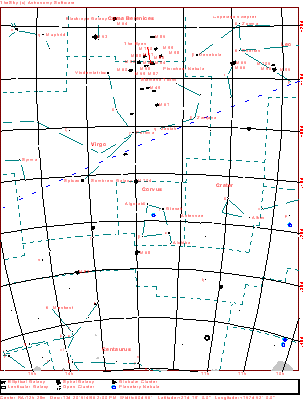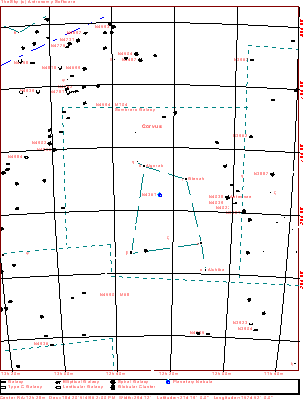
| Home | Deepsky Atlas | TheAstronews | Links | Solar System | ||||||

Hawaiian Astronomical SocietyConstellations: Corvus -- A Slow Crow |
||||||||||
She was attracted to a mere mortal, and foolish indeed to hope that Apollo would not learn of her unfaithfulness. What she didn't know was that one of Apollo's crows was spying on her. The bird immediately flew to Apollo and related the bad news. Learning of Coronis' infidelity made his blood boil. Apollo in a fit of furious anger, and with the complete injustice the gods usually showed when they were angry, punished the faithful crow by turning his feathers black and took away his ability to speak for bringing in the bad news (all of the other crows met the same fate). Of course Coronis was killed. Some say that the god did it himself, others that he got his twin sister Artemis to shoot an unerring arrow at her.
Another story tells that Apollo sent a crow to fetch water in the god's cup. The crow got back very late, because he ate some luscious figs before returning. He brought back a water snake along with the water-filled cup and told Apollo that the serpent had caused the delay. The god, however, could not be deceived by the lie. The angry god placed the crow, the cup (Crater) and the water snake (Hydra) among the stars, where the snake guards the water from the everlastingly thirsty crow.
Finally, this is not exactly mythological, unless you count the Bible as mythology, but Corvus is also associated with a raven in the Noah's Ark story. After the famous flood, Noah first released a raven to find dry land, but the bird never returned. Seven days later, this time Noah released a dove for the same task. The dove soon brought back a freshly plucked olive leaf in her beak. By the way, this dove is associated with the constellation of Columba, the Dove.

Click the map for a 909x1199 version of the above. Click here for a map better suited for use in the field.

This a more detailed view of the constellation. The map displays stars to magnitude 10, and deepsky objects to magnitude 12. Click here for a map better suited for use in the field.
 25k JPEG NGC4361 (Best 32) is a mag. 10 planetary nebula 1.8' in diameter, described as bright, round, and slowly brightening toward the middle. You find it in the top third of Corvus' lozenge shaped figure. 25k JPEG NGC4361 (Best 32) is a mag. 10 planetary nebula 1.8' in diameter, described as bright, round, and slowly brightening toward the middle. You find it in the top third of Corvus' lozenge shaped figure.
|
 60k JPEG Caldwell 60-61 are a pair of interacting galaxies called the Antenae, or the Ring Tailed Galaxies. They are located near the western border of the constellation, and in the top, left of the photograph. Faint, long streamers of gas and stars give the galaxies their name. Dreyer describes 4038 as fairly bright (mag. 10.9), quite large (2.6'x1.8'), round, with only a slow brightening toward the middle. 4039 (immediately south, or below in the photograph) is fairly faint and fairly large. The streamers show up best in photographs. NGC4027 (mag, 11.7) is in the bottom, right of the photograph, 42' away. It shows similar distortions and the Antenae, but no streamers. From the Digital Sky Survey. 60k JPEG Caldwell 60-61 are a pair of interacting galaxies called the Antenae, or the Ring Tailed Galaxies. They are located near the western border of the constellation, and in the top, left of the photograph. Faint, long streamers of gas and stars give the galaxies their name. Dreyer describes 4038 as fairly bright (mag. 10.9), quite large (2.6'x1.8'), round, with only a slow brightening toward the middle. 4039 (immediately south, or below in the photograph) is fairly faint and fairly large. The streamers show up best in photographs. NGC4027 (mag, 11.7) is in the bottom, right of the photograph, 42' away. It shows similar distortions and the Antenae, but no streamers. From the Digital Sky Survey.
|
If you have any questions about the Hawaiian Astronomical Society
please
(link requires javascript).